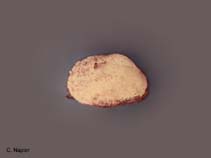Barbatia decussata (Sowerby, 1833)
Classification / Names ชื่อสามัญ | ชื่อพ้อง | CoL | ITIS | WoRMS
Bivalvia | Arcida | Arcidae
Environment: milieu / climate zone / ระดับความลึก / distribution range นิเวศวิทยา
เกี่ยวกับหินโสโครก, usually 20 - 20 m (อ้างอิง 75831). Tropical
Distribution ประเทศต่างๆ | พื้นที่จำแนกตาม FAO | ระบบนิเวศหลายระบบ | การปรากฏขึ้น,การเกิดขึ้น,พบ | การแนะนำ
Indo-Pacific: East Africa to Polynesia.
Length at first maturity / ขนาด / Weight / Age
วัยเจริญพันธุ์: Lm ? range ? - ? cm Max length : 7.0 cm SHL เพศผู้/กระเทย; (อ้างอิง 80041)
Life cycle and mating behavior วัยเจริญพันธุ์ | การสืบพันธุ์ | การวางไข่ | Eggs | ความดกของไข่ | Larvae
Main reference
อ้างอิง | ผู้ประสานงาน | ผู้ร่วมมือ
Spurgeon, A. 2007 New Zealand Mollusca. http://www.mollusca.co.nz/index.php (อ้างอิง 8121)
IUCN Red List Status
(อ้างอิง 130435: Version 2025-1)
CITES status (อ้างอิง 108899)
CMS (อ้างอิง 116361)
Threat to humans
Human uses
| FishSource |
เครื่องมือ
ข้อมูลเพิ่มเติม
องค์ประอบของอาหาร
การบริโภคอาหาร
ผู้ล่า
Max. ages / sizes
Length-weight rel.
Length-length rel.
Length-frequencies
Mass conversion
อุดมสมบรูณ์
แหล่งที่มาจากอินเตอร์เน็ต
BHL | BOLD Systems | CISTI | DiscoverLife | FAO(Publication : search) | Fishipedia | GenBank (genome, nucleotide) | GloBI | Gomexsi | Google Books | Google Scholar | Google | PubMed | แผนภูมิชีวิตแบบต้นไม้ | Wikipedia (Go, ค้นหา) | บันทึกทางด้านสัตววิทยา



